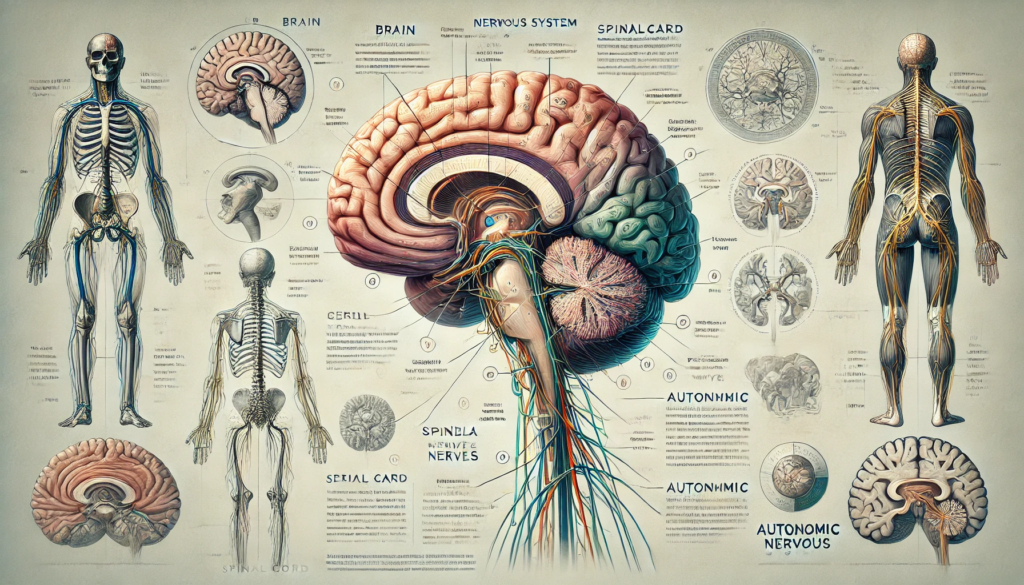The nervous system is a complex network that coordinates the body’s activities, processes sensory information, and enables communication between different parts of the body. It is divided into two main components: the central nervous system (CNS) and the peripheral nervous system (PNS). This guide provides an overview of the anatomy of the brain, spinal cord, and peripheral nerves, along with their functions.
Central Nervous System (CNS)
The central nervous system consists of the brain and spinal cord. It serves as the main control center for the body, processing information and coordinating actions.
Brain
The brain is a highly complex organ responsible for processing sensory information, regulating bodily functions, and enabling thought, emotion, and behavior.
Major Regions of the Brain
- Cerebrum: The largest part of the brain, divided into two hemispheres, each responsible for different functions. The cerebrum controls voluntary movements, sensory perception, language, reasoning, and memory. It is further divided into four lobes:
- Frontal Lobe: Involved in decision-making, problem-solving, and motor control.
- Parietal Lobe: Processes sensory information such as touch, temperature, and pain.
- Occipital Lobe: Responsible for visual processing.
- Temporal Lobe: Involved in hearing, memory, and speech.
- Cerebellum: Located beneath the cerebrum, it is responsible for coordinating voluntary movements, maintaining posture, and balance.
- Brainstem: Connects the brain to the spinal cord and controls essential functions such as heart rate, breathing, and sleep-wake cycles. It consists of the midbrain, pons, and medulla oblongata.
Spinal Cord
The spinal cord is a long, cylindrical structure that extends from the base of the brain down the vertebral column. It serves as a major conduit for transmitting information between the brain and the rest of the body.
Structure and Function
- Gray Matter: The inner region of the spinal cord, containing nerve cell bodies and synapses.
- White Matter: The outer region, consisting of myelinated nerve fibers that transmit signals.
- Spinal Nerves: Paired nerves that emerge from the spinal cord and connect to the peripheral nervous system. They transmit sensory and motor information.
The spinal cord is involved in reflex actions, such as the withdrawal reflex, and transmits sensory information to the brain and motor commands from the brain to the muscles.
Peripheral Nervous System (PNS)
The peripheral nervous system consists of all the nerves outside the central nervous system. It connects the CNS to the rest of the body and is divided into the somatic and autonomic nervous systems.
Somatic Nervous System
The somatic nervous system controls voluntary movements and transmits sensory information to the CNS. It includes:
- Sensory Nerves: Carry sensory information from receptors in the skin, muscles, and joints to the CNS.
- Motor Nerves: Transmit commands from the CNS to skeletal muscles, enabling voluntary movements.
Autonomic Nervous System
The autonomic nervous system regulates involuntary bodily functions, such as heart rate, digestion, and respiratory rate. It is divided into two main branches:
- Sympathetic Nervous System: Prepares the body for “fight or flight” responses by increasing heart rate, dilating airways, and mobilizing energy stores.
- Parasympathetic Nervous System: Promotes “rest and digest” activities by slowing the heart rate, stimulating digestion, and conserving energy.
Conclusion
The nervous system is an intricate network that controls and coordinates all bodily functions. The central nervous system, comprising the brain and spinal cord, serves as the control center, while the peripheral nervous system connects the CNS to the rest of the body. Understanding the structure and functions of the nervous system provides insight into how the body processes sensory information, executes movements, and maintains homeostasis. This knowledge is crucial for understanding human behavior, diagnosing neurological disorders, and developing treatments.
Frequently Asked Questions
What are the main functions of the nervous system?
The nervous system controls and coordinates bodily functions, processes sensory information, and enables communication between different parts of the body. It regulates voluntary actions like movement and involuntary actions like heart rate, digestion, and breathing.
How does the brain process information?
The brain processes information by receiving sensory inputs through sensory nerves, interpreting these signals in various brain regions, and then sending out appropriate responses through motor nerves. Different areas of the brain are specialized for different functions, such as movement, sensation, memory, and emotion.
What is the difference between the central and peripheral nervous systems?
The central nervous system (CNS) consists of the brain and spinal cord, acting as the control center for the body. The peripheral nervous system (PNS) includes all the nerves outside the CNS and connects the brain and spinal cord to the rest of the body. The PNS is further divided into the somatic and autonomic nervous systems.
How does the spinal cord contribute to reflex actions?
The spinal cord facilitates reflex actions by acting as a direct pathway for sensory and motor signals. Reflexes are automatic responses to stimuli that occur without conscious thought. For example, touching a hot object triggers a withdrawal reflex, where sensory neurons send a signal to the spinal cord, which then immediately sends a signal to the muscles to pull the hand away.
What role does the autonomic nervous system play in the body?
The autonomic nervous system (ANS) regulates involuntary bodily functions, such as heart rate, digestion, and respiratory rate. It consists of two branches: the sympathetic nervous system, which prepares the body for “fight or flight” responses, and the parasympathetic nervous system, which promotes “rest and digest” activities.
Can damage to the nervous system be repaired?
The ability to repair nervous system damage depends on the extent and location of the injury. While peripheral nerves have some capacity for regeneration, the central nervous system has limited ability to repair itself. Advances in medical research, including neuroplasticity and regenerative medicine, offer hope for potential treatments and recovery.



